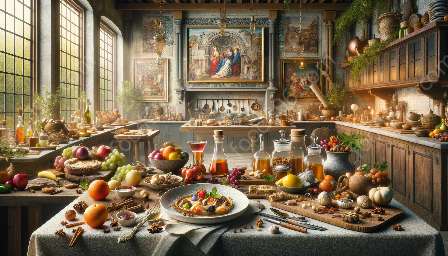During the Renaissance, the culinary practices of the nobility were a reflection of their wealth, power, and social status. This era witnessed an explosion of creativity and artistry in the kitchen, resulting in a rich and diverse culinary heritage that continues to influence modern cuisine. Let's delve into the sumptuous world of Renaissance nobility and explore the extravagant feasts, exotic ingredients, and cultural significance of their culinary traditions.
The Renaissance Era
The Renaissance, which spanned from the 14th to the 17th century, was a time of great cultural, artistic, and intellectual rebirth in Europe. This period saw the emergence of new ideas, scientific advancements, and the flourishing of art, music, and literature. It was also a time of exploration and discovery, with the spice trade and exploration of new lands bringing exotic ingredients and culinary influences to Europe.
Culinary Riches of the Nobility
The nobility of the Renaissance era enjoyed a level of culinary opulence that reflected their wealth and status. Their culinary practices were characterized by extravagant feasts, lavish banquets, and an abundance of exotic and expensive ingredients. The nobility spared no expense in creating lavish displays of food, showcasing their power and sophistication through the art of dining.
Extravagant Feasts and Banquets
Feasts and banquets were central to the social and political life of the nobility during the Renaissance. These events were elaborate affairs, featuring a profusion of dishes, elaborate table settings, and entertainment. The nobility and their guests were treated to a sensory experience that included opulent decorations, music, and theatrical performances.
Exotic Ingredients and Flavors
The Renaissance nobility had access to a wide range of exotic ingredients, thanks to the exploration and trade routes of the era. Spices such as cinnamon, cloves, nutmeg, and pepper were highly sought after and used to enhance the flavors of dishes. The use of sugar, imported fruits, and sweet wines also became prominent, leading to the development of intricate and indulgent desserts.
Cultural Significance
Renaissance cuisine had a profound cultural significance, serving as a symbol of wealth, power, and refinement. The culinary practices of the nobility were closely intertwined with art, architecture, and fashion, creating a multi-sensory experience that celebrated the opulence of the era. Banquets and feasts became showcases of culinary mastery and creativity, with skilled chefs and kitchen staff striving to impress and delight their noble patrons.
Influence on Cuisine History
The culinary practices of the Renaissance nobility had a lasting impact on the history of cuisine. Their extravagant feasts, innovative use of ingredients, and emphasis on culinary artistry laid the foundation for future culinary developments. The fusion of flavors and the introduction of new ingredients from distant lands enriched European cuisine and inspired the evolution of new cooking techniques and recipes.
Legacy of Renaissance Cuisine
Many of the culinary practices and techniques developed by the Renaissance nobility continue to influence modern cuisine. The use of spices, intricate desserts, and elaborate dining rituals can be traced back to the opulent dining experiences of the Renaissance era. The legacy of Renaissance cuisine lives on in the rich tapestry of flavors, aromas, and rituals that define contemporary culinary artistry.
Artistic Expression and Innovation
Renaissance cuisine was not only a display of wealth and prestige but also a form of artistic expression and innovation. Chefs and culinary artists of the era pushed the boundaries of creativity, experimenting with flavors, textures, and presentations to create culinary works of art. This emphasis on culinary creativity and innovation laid the groundwork for the development of haute cuisine and gastronomic excellence.

